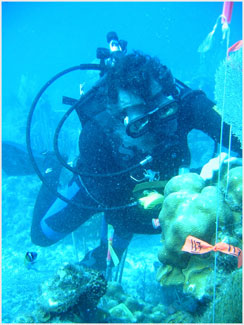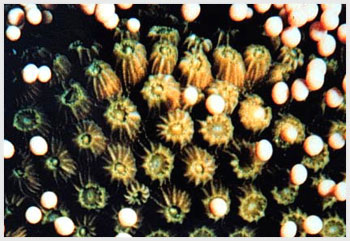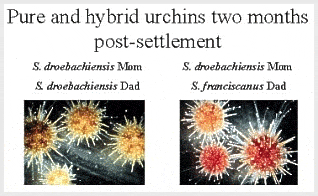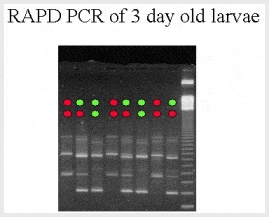 |
 |
|
Don tagging corals that spawned the night before in Carrie Bow Cay, Belize |
Coral spawning in the Caribbean |
The formation and maintenance of species in the sea is an interesting but poorly understood phenomenon. It is interesting because there are no obvious barriers to migration and gene flow in the sea and, for many taxa with external fertilization, gametes from many species may mix in the ocean during spawning. It is poorly understood because following the fate of gametes and larvae in the vast ocean is problematic. I have been studying reproductive isolation and hybridization in both Caribbean corals and temperate sea urchins. The coral project in collaboration with Nancy Knowlton (Scripps Institute of Oceanography) is exploring how three very closely related species that all spawn on the same evening can maintain reproduction isolation. The sea urchin project is investigating how, in well-defined species, isolating mechanisms can fail resulting in hybridization under certain demographic conditions. Recently, I have been collaborating with a PhD student at FSU, Maurizio Tomaiuolo, in a theoretical exploration of how varying conditions of spawning ecology can result in sympatric speciation.
 |
 |
|
Urchin hybridization in the Pacific Northwest |
Known crosses between red and green urchins |
Relevant Publications:
2014 Levitan, D.R., W. Boudreau, J. Jara and N. Knowlton. Long-term reproductive consequences of bleaching stress on the Caribbean corals of the Orbicella (formerly Montastraea) annularis species complex. Marine Ecology Progress Series 515:1-10 [PDF].
2012 Fogarty, N.D., M. Lowenberg, M.N. Ojima, N. Knowlton and D.R. Levitan. Asymmetric conspecific sperm precedence in relation to spawning times in the Montastraea annularis species complex (Cnidaria: Scleractinia). Journal of Evolutionary Biology 25:2481-2488 [PDF].
2012 Fogarty, N. D.; S. V. Vollmer, and D. R. Levitan. Weak prezygotic isolating mechanisms in threatened caribbean Acropora corals. PLoS One 7:e30486 [PDF].
2011 Levitan, D. R., N. D. Fogarty, J. Jara, K. E. Lotterhos, and N. Knowlton. Genetic, spatial, and temporal components of precise spawning synchrony in reef building corals of the Montastraea annularis species complex. Evolution 65:1254-1270 [PDF].
2010 Tomaiuolo, M. and D. R. Levitan. Modeling how reproductive ecology can drive protein diversification and result in linkage-disequilibrium between sperm and egg proteins. American Naturalist 176:12-25 [PDF]
2010 Levitan, D.R. and A.P. Stapper. Simultaneous positive and negative frequency dependent selection on sperm bindin, a gamete recognition protein in the sea urchin Strongylocentrotus purpuratus. Evolution 64:785-797 [PDF]
2007 Tomaiuolo, M., T.F. Hansen, D. R. Levitan. A theoretical investigation of sympatric evolution of temporal reproductive isolation as illustrated by marine broadcast spawners. Evolution 61:2584-2595 [PDF]
2006 Levitan, D.R. and D.L. Ferrell. Selection on gamete recognition proteins depends on sex, density and genotype frequency. Science 312:267-269 [PDF] [On-line Supplement PDF]
2005 Zigler, K.S., M.A. McCartney, D.R. Levitan, H.A. Lessios. Sea urchin bindin divergence predicts gamete compatibility. Evolution 59:2399-2404 [PDF]
2004 Levitan, D.R., H. Fukami, J. Jara, D. Kline, T.A. McGovern, K.M. McGhee, C.A. Swanson and N. Knowlton. Mechanisms of reproductive isolation among sympatric broadcast-spawning corals of the Montastraea annularis complex. Evolution 58:308-323. [PDF]
2004 Fukami, H., A.F. Budd, D.R. Levitan, J. Jara, R. Kersanach and N. Knowlton. Geographical differences in species boundaries among members of the Montastraea annularis complex based on molecular and morphological markers. Evolution 58:324-337. [PDF]
2002 Levitan, D.R. The relationship between conspecific fertilization success and reproductive isolation among three congeneric sea urchins. Evolution 56:1599-1609. [PDF]